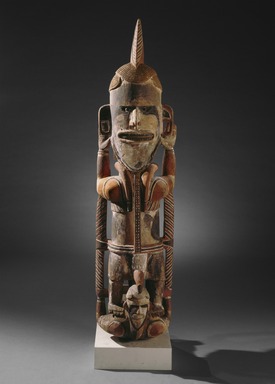
Medium: Wood, Turbo petholatus opercula, pigment, fibers, organic materials
Geograhical Locations:
Dates:19th or early 20th century
Dimensions: 59 x 14 1/4 x 18 1/2 in. (149.9 x 36.2 x 47 cm)
Collections:
Accession Number: 51.234
Image: 51.234_SL3.jpg,
Catalogue Description: Uli (previously written as Olli) figure. The stems of the Holy Giner plant are used as paint brushes for the whitewash and, in the Hamba dialect, they are called Ulis, so this is the probable origin of the word. There are several types of Ulis. The one now in the Brooklyn Museum is called "lembankakat lakos" (lemban, the bushman; kakat, to cut out; lakos, oldtime). The figure stands on a child. A story is told of Sokokau of Paranu who stepped on his child Liu to take the eggs from the nest of the bird avensik and crushed his child. Death is the penalty for women who see the Uli and they are forbidden even to say its name. The Uli figure is a memorial for famous chieftains and is never used for the family. Ten chieftains will usually give the festivals and the order to the carver for the figure. There are 13 separate festivals given in connection with the erection of an Uli--from the wood cutting, transporting, carving, painting, to the final erection of the figure in the Men's Society house, each involves a separate festival with the killing of many pigs. They look like hermaphrodites and in the dances men wear fake wooden breasts which indicate fertility but the figures are thought of as masculine. Ulis are not personal and are often repacked and resold to others who want to erect a memorial. Ancestor figure painted in red, black, and white. Large rectangular Head with waffle-incised hair arranged in three convoluting ovals. A high crest painted red, and striped in front with black, white, and red adorns the head. The eyes on a black background are inlaid with flint (?). The rest of the face was painted white and the wide averted lips reveal two even rows of black teeth. The jutting triangular chin is fringed with a tan beard. The flaring nostrils are bright red while the ears are painted red, white, and black on the top part while the central portion of the lower half of the ear is cut out leaving a red border. The figure has female organs on the top half of the body, and a penis on the lower. From the two elbows bent away from the body the hands are uplifted with the palms facing front. Two striped staffs continue from the elbows to the base. The short body and legs are minimized by the large arresting head. Beneath the feet a smaller figure (child) on its stomach raises its head which is blacked at the eyes. It has a pointed chin and beard and has its hair in three circular sections. It is also painted in patterns of red, black, and white. The female organs project forward and the legs are raised in the back which is the half that contains the male organ. Condition: good. Some flaking of paint. (From catalogue card)